TechRadar Verdict
The Lapdog comes the closest yet to replicating the feeling of playing PC games at a desk while kicking back on the couch. However, its labored set-up and long USB cable mean it's less convenient than its lapboard rivals.
Pros
- +
Works with mechanical keyboards
- +
Desk-like experience
- +
Comfortable
- +
USB 3.0 ports
Cons
- -
No left-handed option
- -
Huge on the lap
- -
Fiddly to set up
- -
Mouse slips
Why you can trust TechRadar
A largely solitary activity, PC gaming has never convincingly blended in with the household's most social environment: the living room. That could be set to change following lapboards such as the Razer Turret, Roccat Sova and now the Corsair Lapdog, which aim to replicate the feeling of using a desk while you're kicking back on the couch.
Thanks to Steam Machines, small-yet-mighty gaming PCs and even the falling cost of large 4K TVs, lapboards are about to make an honest play for the living room.
Corsair's Lapdog is the most hardcore of the lot. It even lets you use your own Corsair-branded mechanical K65 or K70 mechanical keyboard with it, unlike its rivals, along with the wired or wireless mouse of your choice.
The unit connects to your computer through USB, rather than wirelessly, eliminating any latency worries. That's great news for hardcore gamers, but does it make the Lapdog an impractical option?
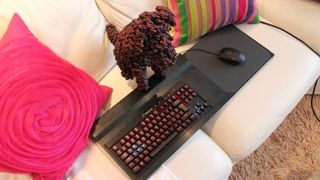
Out now priced at £110 (around US$160, or AUS$224), the Lapdog is also being offered as part of a bundle with Corsair's non-RGB, K70 mechanical keyboard that's available with with Cherry's MX Blue or Red switches for £190 (around $277, or AUS$386).
Doing so cuts £30 (around $40 or AUS$61) from the total cost of picking them up separately.
Dog's dinner
The Lapdog is the biggest lapboard yet by a wide margin. If it were an actual canine, it would be one of those slobbery Great Danes that make you disappear into the couch when it lays across you.
The unit is also extremely sharp, both in looks and construction. The first time I went to pick it up without looking, I was given a centimeter-long cut in my finger that bled for a few hours. Guess what my next move was? That's right: I sanded it down, sanded it good.
Setting up the Lapdog was a frustrating experience the first time around, largely due to my own catalog of errors rather than anything to do with the unit's design. The first step is to remove the long backplate that covers the wires, which is done using a supplied allen key.
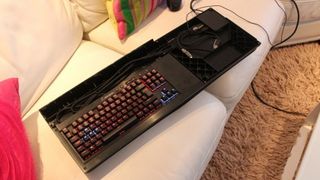
My keyboard, Corsair's tenkeyless K65 that uses Cherry's Rapidfire MX Switch, slotted in nicely; though strangely enough the first time I attempted this seemingly simple maneuver, the keyboard refused to cooperate.
No matter how hard I pressed it down, the rear of the K65 was raised too high, preventing the wire cover from screwing back on. Had I inserted it the wrong way? Or was it just a tight fit? As it happened, I'd accidentally left the K65's two elevation feet sticking out. Yes, I felt a bit stupid.
With the keyboard eventually tucked in, the K65's thick, braided USB cable snaked into the wiring compartment and connected to a vacant internal USB port. One tip here is to plug the cable into the USB port first and then feed the wire into the empty compartment, using the supplied cable ties to prevent it from springing back up again.

After screwing the various plates back on, all that's left is to feed the Lapdog's long USB cable to your computer. That cable is particularly conspicuous due to its thickness and length.
It doesn't look tidy and creates something of a trip hazard unless you tuck it under a carpet. So, if you're living with people who don't like cables lying around then you're going to have to find a way of hiding it out of view. One that involves duct tape, preferably.
The Lapdog requires power for its external USB 3.0 ports to work. As such, it comes with a charge plug that's on the end of a cable long enough to stretch to a nearby wall outlet. Those USB ports can be used for anything from charging smartphones to connecting USB mice, headphones or other accessories; even wireless ones, if they come with a receiver.
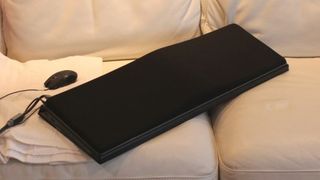
Prize performer
I used the Lapdog over the course of a week in my living room, which isn't exactly primed for PC gaming. My 32-inch TV is raised a good seven feet up the wall, which causes the occasional bout of neck pain after prolonged periods of Counter-Strike: Global Offensive and League of Legends.
But, I didn't experience any pain using the Lapdog itself, bleeding finger aside. Despite being made from the same grade-A aluminum as Corsair's flagship keyboards, the Lapdog never feels heavy on the lap.
That's partly thanks to the memory foam cushion that magnetically latches onto the underside of the Lapdog, which absorbs the weight of the keyboard and lapboard rested upon it.
My only criticism of the memory foam cushion is that the bump on the underside is located in the center, which suggests that it should sit in-between your legs.
I find that doing this positions the keyboard too far to the left, resulting in an awkward, testing movement in my shoulders when it comes to typing.
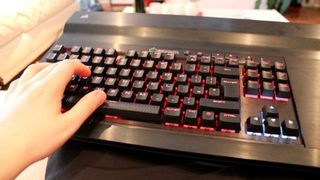
Shifting the Lapdog slightly further to the left to position the keyboard directly in front of me (and stretching my right arm a little further toward the mouse) makes for a much more comfortable typing position, although this moves the bump directly over my left knee.
That isn't a huge problem, but, for a right-handed lapboard, it feels like the bump should have been positioned slightly further to the left. You can use the Lapboard without the foam bit, but I prefer it connected – bump and all.
Aiming at enemies and selecting units feels just as natural and smooth as it does when sat at a desk, although the mouse slips occasionally when I lean back on the couch due to the mouse pad's plastic, non-grip surface. Finding a sticky mouse mat with a textured surface might be one way to solve that.
I would suggest that Corsair make the mouse mat magnetic, like Razer has with its Turret lapboard. But, that would require the purchasing of a dedicated magnetic mouse.
Using your own kit is a huge part of the attraction here. Besides, my techradar colleague Kevin Lee didn't find Razer's magnetic approach all that convincing in his review of that product anyway.
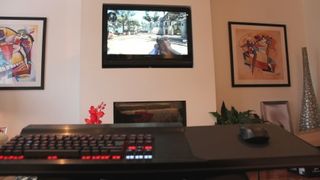
We liked
The Lapdog is a well-built animal that comes the closest to providing a desk-like experience while kicking back on the couch. Being able to use a full-sized mechanical keyboard and gaming mouse is a real boon for both gaming and productivity work, and for the first time you could realistically swap your bedroom chair for the couch for all of your gaming and work activities.
Corsair has designed the Lapdog so that you can use its successive mechanical keyboards with it, so you won't have to buy a new lapboard each time. And, thanks to the three powered external USB 3.0 ports, you can chop and change USB peripherals as you wish. The Lapdog is a great big hound but won't hurt your knees, thanks to its generous-sized foam cushion, even if you have to shift it around a bit to find the ideal position.
We disliked
There's no escaping the fact that it's massive – almost unbearably so. It may not cause any physical pain due to its cushioned underside, but shaving a few inches from the Lapdog's thickness and length would go a long way to improving its overall comfort level.
Setting it up isn't difficult once you know what you're doing, but there's still a lot of fiddling around with screws and messing with wires and cable ties. If you're going to be switching between your bedroom desk and the living room couch frequently, then buying two keyboards is the only way to prevent a headache.
There's no left-handed option either, so tough luck there. And if you share a living room with others, you'd better hope they aren't fussy about tidiness, as that long snaking USB cable isn't the easiest to hide out of view.
Final verdict
Compromise is at the heart of the Lapdog experience. It's not the most convenient lapboard out there, but if you're looking to replicate the feeling of using a keyboard and mouse on a desk while you're sat on the couch then nothing else comes close.
The real draw is being able to use Corsair's mechanical keyboards with the lapboard, which makes lengthy casual and competitive play in the living room an honestly feasible option for the first time.


